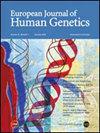CILK1基因的纯合子移码变异导致颅外胚层发育不良。
IF 4.6
2区 生物学
Q2 BIOCHEMISTRY & MOLECULAR BIOLOGY
引用次数: 0
摘要
颅外胚层发育不良(CED)是一种以骨骼和外胚层异常、肾功能衰竭和肝纤维化为特征的纤毛病。编码鞭毛内转运(IFT)复合物组分的基因的致病变异,特别是IFT- a,导致大约三分之二的CED病例。然而,其余病例的病因尚不清楚。纤毛发生相关激酶1 (CILK1)是一种高度保守的纤毛丝氨酸/苏氨酸激酶,其n端催化结构域负责激酶活性,c端非催化结构域与IFT-B复合物相互作用。催化结构域的双等位基因变异与致死性骨骼发育不良、内分泌-脑-骨骼发育不良和短肋多指综合征有关。没有任何人类疾病与非催化结构域的双等位基因变异有关。我们在CILK1基因中发现了一个纯合子移码变体,它影响非催化结构域的远端部分,导致来自两个谱系的5名患者发生CED。所有的患者都存活到儿童时期,并出现不成比例的身材矮小、骨骼异常、外胚层发育不良、肾脏问题和肝脏并发症。来自患者来源细胞和秀丽隐杆线虫模型的功能数据表明,该变体减少了纤毛数量,增加了纤毛长度,并破坏了IFT成分的定位。相比之下,携带变异本身的CILK1的纤毛定位不受影响。值得注意的是,我们通过将CILK1重新引入患者来源的细胞中,挽救了大多数这些异常。最后,我们的研究将CILK1描述为CED病因学中的一个新的致病基因和第一个非ift蛋白编码基因,从而扩大了CED的已知基因型,机制和表型谱。本文章由计算机程序翻译,如有差异,请以英文原文为准。

A homozygous frameshift variant in the CILK1 gene causes cranioectodermal dysplasia
Cranioectodermal dysplasia (CED) is a ciliopathy characterized by skeletal and ectodermal abnormalities, renal failure, and liver fibrosis. Pathogenic variants in genes that encode the intraflagellar transport (IFT) complex components, particularly IFT-A, are responsible for approximately two-thirds of the CED cases. However, the cause of the remaining cases remains unknown. Ciliogenesis-associated kinase 1 (CILK1) is a highly conserved ciliary serine/threonine kinase with an N-terminal catalytic domain responsible for kinase activity and a C-terminal non-catalytic domain that interacts with the IFT-B complex. Biallelic variants in the catalytic domain are associated with lethal skeletal dysplasia, endocrine cerebroosteodysplasia, and short-rib polydactyly syndrome. No human disease has been linked to biallelic variants in the non-catalytic domain. We present a homozygous frameshift variant in the CILK1 gene that affects the distal part of the non-catalytic domain, causing CED in five patients from two pedigrees. All the patients survived into childhood and had disproportionately short stature, skeletal abnormalities, ectodermal dysplasia, renal issues, and liver complications. Functional data from patient-derived cells and the C. elegans model indicate that the variant reduces cilia number, increases cilia length, and disrupts the localization of IFT components. In contrast, the ciliary localization of CILK1 bearing the variant itself remains unaffected. Notably, we rescued the majority of these abnormalities by reintroducing CILK1 into patient-derived cells. Finally, our study describes CILK1 as a novel causal gene and the first non-IFT protein-encoding gene in the etiology of CED, thus expanding the known genotypic, mechanistic, and phenotypic spectrum of CED.
求助全文
通过发布文献求助,成功后即可免费获取论文全文。
去求助
来源期刊

European Journal of Human Genetics
生物-生化与分子生物学
CiteScore
9.90
自引率
5.80%
发文量
216
审稿时长
2 months
期刊介绍:
The European Journal of Human Genetics is the official journal of the European Society of Human Genetics, publishing high-quality, original research papers, short reports and reviews in the rapidly expanding field of human genetics and genomics. It covers molecular, clinical and cytogenetics, interfacing between advanced biomedical research and the clinician, and bridging the great diversity of facilities, resources and viewpoints in the genetics community.
Key areas include:
-Monogenic and multifactorial disorders
-Development and malformation
-Hereditary cancer
-Medical Genomics
-Gene mapping and functional studies
-Genotype-phenotype correlations
-Genetic variation and genome diversity
-Statistical and computational genetics
-Bioinformatics
-Advances in diagnostics
-Therapy and prevention
-Animal models
-Genetic services
-Community genetics
 求助内容:
求助内容: 应助结果提醒方式:
应助结果提醒方式:


